
ROLE
Product Designer
UX Researcher
TIMELINE
January 2025 - March 2025
TEAM
Me myself and I!
TOOLS
Figma
Cardboard
BACKGROUND
BACKGROUND
The Daily Northwestern is the main source of campus news for students.
The Daily Northwestern is the main source of campus news for students.
The Daily Northwestern is the main source of campus news for students.
The Daily Northwestern is one of the oldest organizations at Northwestern University dating all the way back to 1881 for when it was first founded and printed. It is highly composed of undergraduate Northwestern Medill School of Journalism students.
The Daily Northwestern is one of the oldest organizations at Northwestern University dating all the way back to 1881 for when it was first founded and printed. It is highly composed of undergraduate Northwestern Medill School of Journalism students.



IDENTIFYING CORE USERS & STAKEHOLDERS
IDENTIFYING CORE USERS & STAKEHOLDERS
Thinking about all the different stakeholders that are impacted through this project.
Thinking about all the different stakeholders that are impacted through this project.
Thinking about all the different stakeholders that are impacted through this project.
After discussing with the Editor in Chief of The Daily, I was able to identify key players within this project and how each of them may be impacted through this project.
After discussing with the Editor in Chief of The Daily, I was able to identify key players within this project and how each of them may be impacted through this project.
User Groups
User Groups

News Readers
Stakeholders
Stakeholders


Article Writers


Editor in Chief
LEARNING & EXPLORING
LEARNING & EXPLORING
Aligning myself with important goals from stakeholders.
Aligning myself with important goals from stakeholders.
Aligning myself with important goals from stakeholders.
After fully understanding who I was designing for as well as who the different stakeholders are within this project, I began to dig deeper and conducted stakeholder research to understand the major goals that came from all the major players at The Daily Northwestern. Interviews were done both through in-person participants and stakeholder interviews done virtually
After fully understanding who I was designing for as well as who the different stakeholders are within this project, I began to dig deeper and conducted stakeholder research to understand the major goals that came from all the major players at The Daily Northwestern. Interviews were done both through in-person participants and stakeholder interviews done virtually






Understanding what business objectives I'm designing for.
Understanding what business objectives I'm designing for.
Understanding what business objectives I'm designing for.
After discussions with stakeholders, I began to understand more of the business goals and problems that The Daily Northwestern was facing. Through stakeholder interviews, it brought an entirely new perspective to the overall design process and allowed me to develop basic goals for this particular project to allow me to keep in mind what major business goals I am trying to achieve throughout this project
Some of those goals were as follows…
After discussions with stakeholders, I began to understand more of the business goals and problems that The Daily Northwestern was facing. Through stakeholder interviews, it brought an entirely new perspective to the overall design process and allowed me to develop basic goals for this particular project to allow me to keep in mind what major business goals I am trying to achieve throughout this project
Some of those goals were as follows…
Increasing Student Readership
Increasing Writer Motivation
CURRENT STATE ANALYSIS
CURRENT STATE ANALYSIS
The Daily's current distribution network is mainly through two major sources.
The Daily's current distribution network is mainly through two major sources.
The Daily's current distribution network is mainly through two major sources.
One major method that the Daily distributes its articles is through the weekly emailing list called "The Daily Digest." Through this newsletter, students are able to obtain constant updates on different events or news happening across both on campus and throughout the college town of Evanston, Illinois. The newsletter automatically re-directs individuals to The Daily's news website. They also have different printing editions but are much less common compared to the newsletters.
One major method that the Daily distributes its articles is through the weekly emailing list called "The Daily Digest." Through this newsletter, students are able to obtain constant updates on different events or news happening across both on campus and throughout the college town of Evanston, Illinois. The newsletter automatically re-directs individuals to The Daily's news website. They also have different printing editions but are much less common compared to the newsletters.



THE PROBLEM
THE PROBLEM
HMW create another pathway to spark interest in users to read the local news at Northwestern University?
HMW create another pathway to spark interest in users to read the local news at Northwestern University?
HMW create another pathway to spark interest in users to read the local news at Northwestern University?
USER RESEARCH
USER RESEARCH
How do Northwestern students interact with The Daily right now?
How do Northwestern students interact with The Daily right now?
How do Northwestern students interact with The Daily right now?
Northwestern students have different relationships when it comes to using The Daily Northwestern on campus. As I am not incredibly familiar with using The Daily Northwestern, I decided to talk with 10 students about their experiences using The Daily to understand more about the user interactions The Daily has.
Northwestern students have different relationships when it comes to using The Daily Northwestern on campus. As I am not incredibly familiar with using The Daily Northwestern, I decided to talk with 10 students about their experiences using The Daily to understand more about the user interactions The Daily has.
RESEARCH ANALYSIS
RESEARCH ANALYSIS
Analyzing and coding research results.
Analyzing and coding research results.
Analyzing and coding research results.
I wanted to understand more about how current Northwestern students interact with The Daily Northwestern and understand their reactions and emotions when it comes to reading local news. After conducting the interviews, I jotted down various thoughts through post-it notes and on paper to materialize the ideas that I had. I used a research technique called "Coding" where I read through all the notes from the interviews first, then grouped each specific note into various categories by giving them "codes" or labels for better organization.
I wanted to understand more about how current Northwestern students interact with The Daily Northwestern and understand their reactions and emotions when it comes to reading local news. After conducting the interviews, I jotted down various thoughts through post-it notes and on paper to materialize the ideas that I had. I used a research technique called "Coding" where I read through all the notes from the interviews first, then grouped each specific note into various categories by giving them "codes" or labels for better organization.






There were four distinct insights.
There were four distinct insights.
There were four distinct insights.
I wanted to understand more about how current Northwestern students interact with The Daily Northwestern and understand their reactions and emotions when it comes to reading local news. Here were some of the key insights that was obtained from the interviews with various Northwestern students:
I wanted to understand more about how current Northwestern students interact with The Daily Northwestern and understand their reactions and emotions when it comes to reading local news. Here were some of the key insights that was obtained from the interviews with various Northwestern students:












Turning key user insights into opportunity areas for a solution.
Turning key user insights into opportunity areas for a solution.
Turning key user insights into opportunity areas for a solution.
Guided by UX research, I turned these four major key insights of both pain points and points of feedback into potential opportunity areas that could be explored further while also balancing the major goals and needs from the stakeholders as well.
Guided by UX research, I turned these four major key insights of both pain points and points of feedback into potential opportunity areas that could be explored further while also balancing the major goals and needs from the stakeholders as well.









BRAINSTORMING & IDEATION
BRAINSTORMING & IDEATION
Creating a mobile application for easier content distribution and access
Creating a mobile application for easier content distribution and access
Creating a mobile application for easier content distribution and access
When thinking about the first key insight gained from the user interviews, most individuals access various distribution sources from The Daily on their mobile application. So, what better way to ensure that the entry point to actually accessing the news is easy than creating a mobile application that users can download and easily access the news
When thinking about the first key insight gained from the user interviews, most individuals access various distribution sources from The Daily on their mobile application. So, what better way to ensure that the entry point to actually accessing the news is easy than creating a mobile application that users can download and easily access the news



Creating cardboard mockups for testing.
Creating cardboard mockups for testing.
Creating cardboard mockups for testing.
I created an initial batch of mock-ups that would be tested with various users. The mock ups were created through cardboard cut outs with pictures of phones that were glued on as I felt that physical, low-fi prototypes often feel more approachable for users. The users may feel more comfortable giving candid feedback on “paper/cardboard” than on something that looks finished.
I created an initial batch of mock-ups that would be tested with various users. The mock ups were created through cardboard cut outs with pictures of phones that were glued on as I felt that physical, low-fi prototypes often feel more approachable for users. The users may feel more comfortable giving candid feedback on “paper/cardboard” than on something that looks finished.
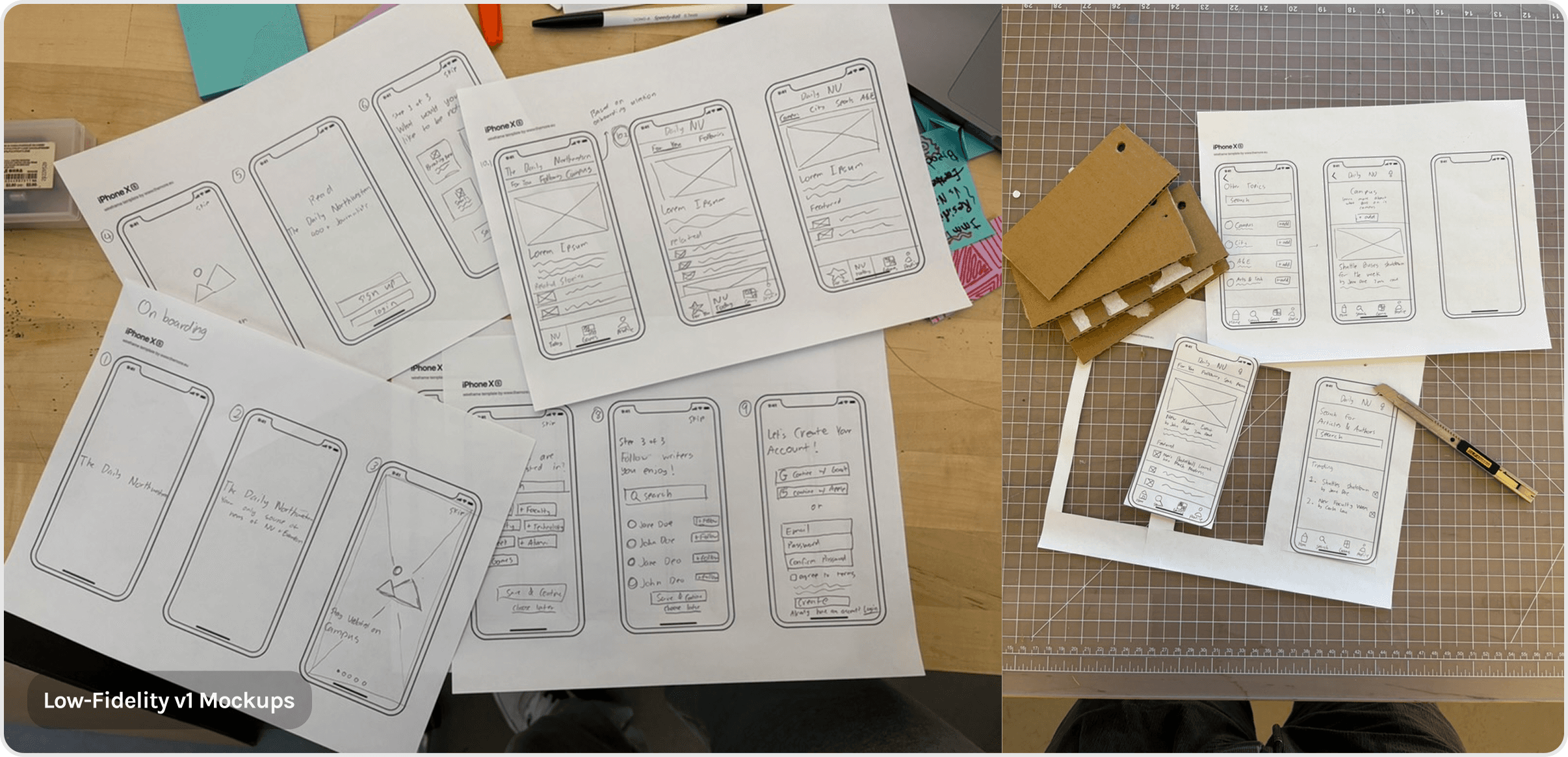


USER TESTING & ITERATIONS
USER TESTING & ITERATIONS
Low-fidelity v1: Initial Testing
Low-fidelity v1: Initial Testing
Low-fidelity v1: Initial Testing
I began to test the first design of the prototype with various users asking them to "scroll" through the entire cardboard prototype.
I began to test the first design of the prototype with various users asking them to "scroll" through the entire cardboard prototype.
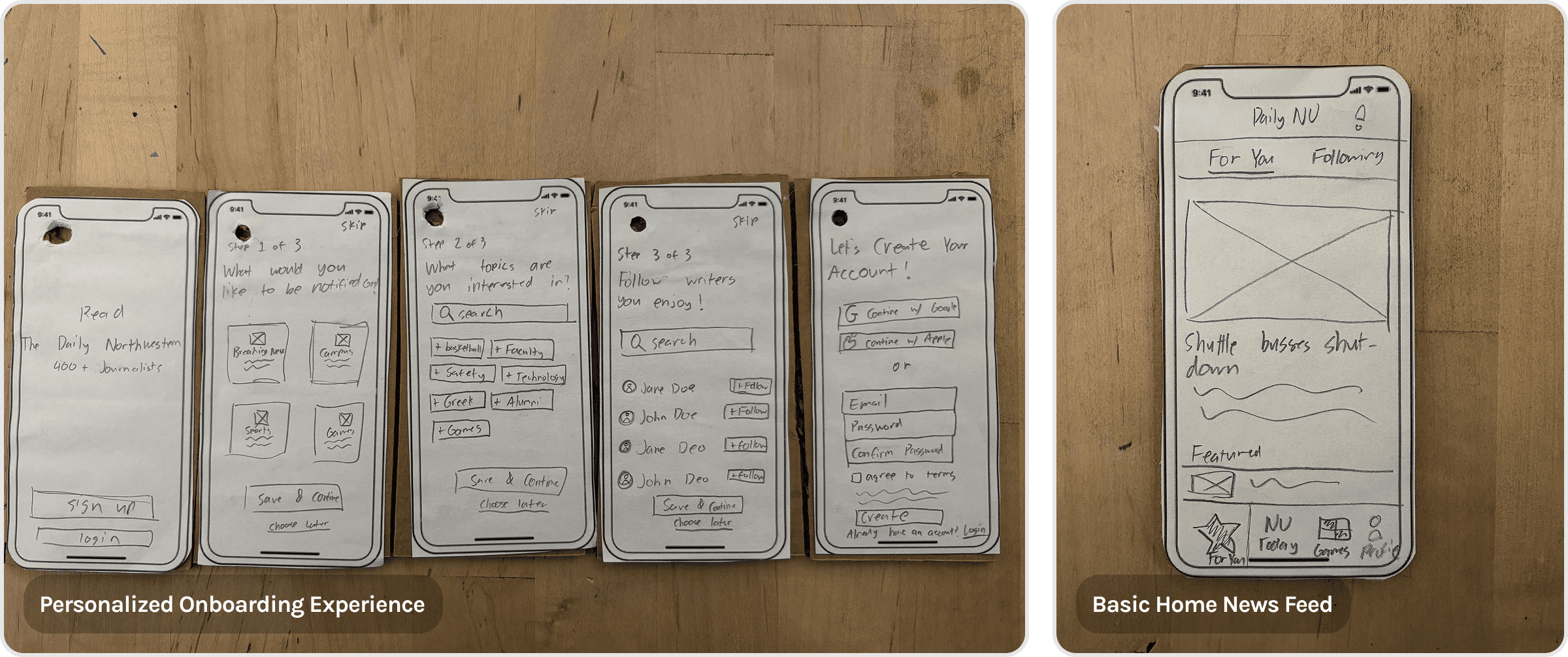


Discovering the importance of planning prototype depth.
Discovering the importance of planning prototype depth.
Discovering the importance of planning prototype depth.
From feedback with two users, I realized that my prototype lacked enough screens and status updates to accurately reflect the user journey. This wasn’t a design flaw, but rather a gap in my understanding of how to scope and plan prototypes for effective testing. This experience taught me the importance of aligning prototype fidelity with clear testing objectives.
From feedback with two users, I realized that my prototype lacked enough screens and status updates to accurately reflect the user journey. This wasn’t a design flaw, but rather a gap in my understanding of how to scope and plan prototypes for effective testing. This experience taught me the importance of aligning prototype fidelity with clear testing objectives.
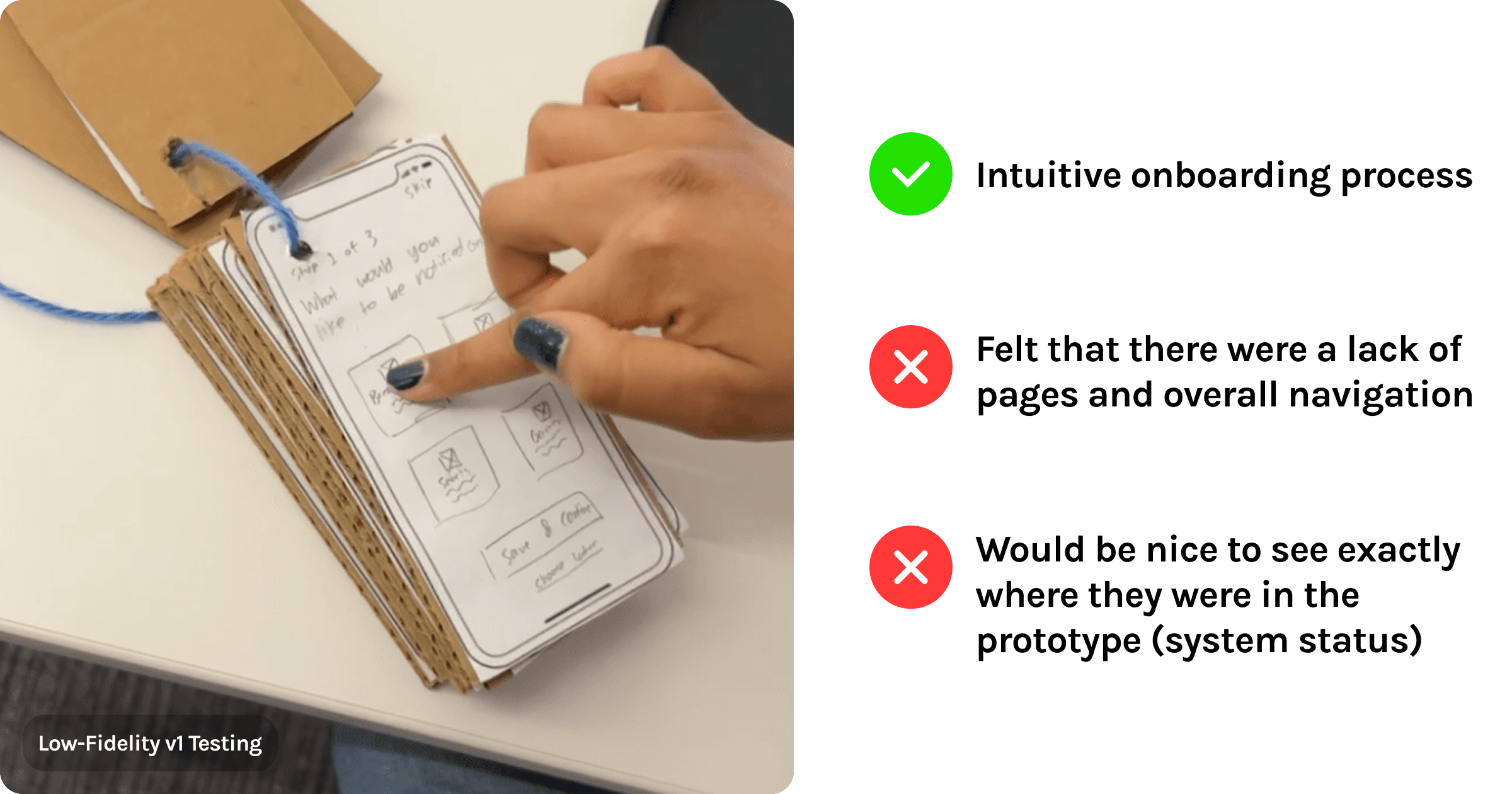


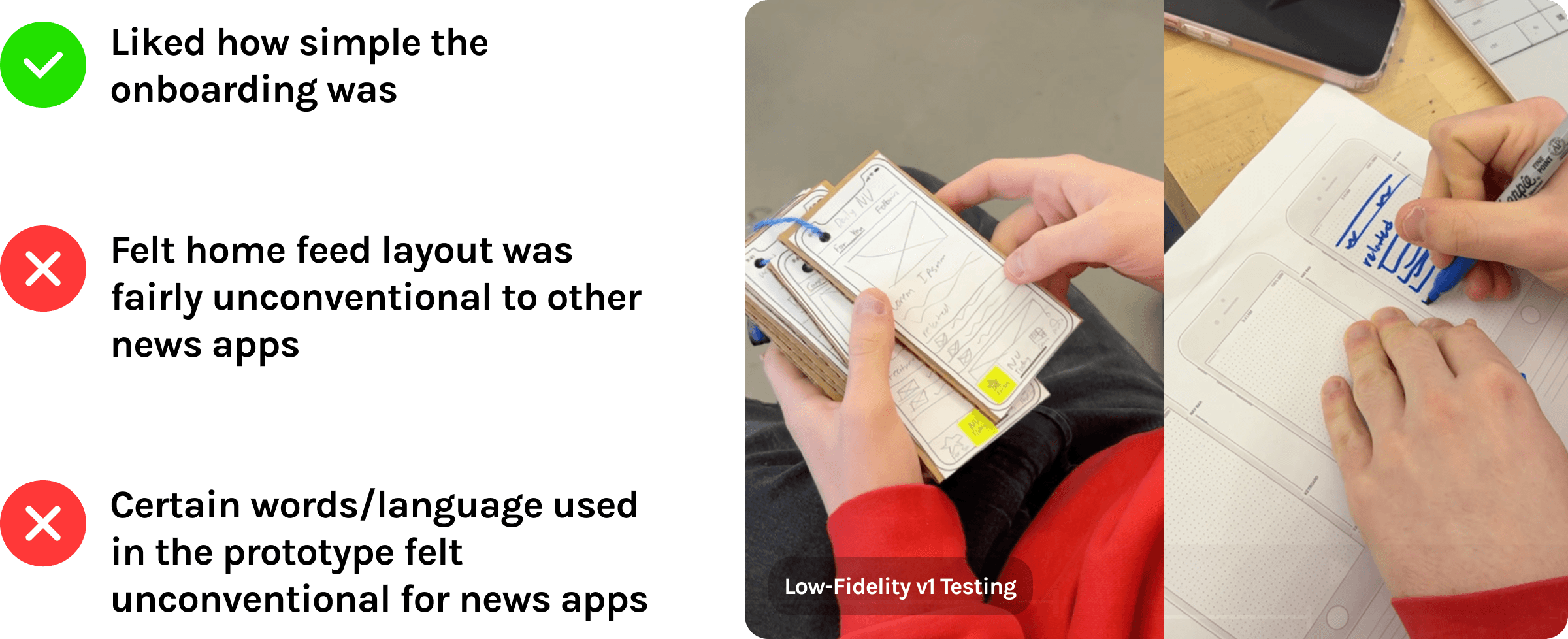


Low-fidelity v2: Applying feedback and creating more thorough user flows.
Low-fidelity v2: Applying feedback and creating more thorough user flows.
Low-fidelity v2: Applying feedback and creating more thorough user flows.
After the early two user tests, I went and created another iteration of the design that would hold much more extensive screens and system status updates to provide users with more clarity on what they were doing on each screen.
After the early two user tests, I went and created another iteration of the design that would hold much more extensive screens and system status updates to provide users with more clarity on what they were doing on each screen.
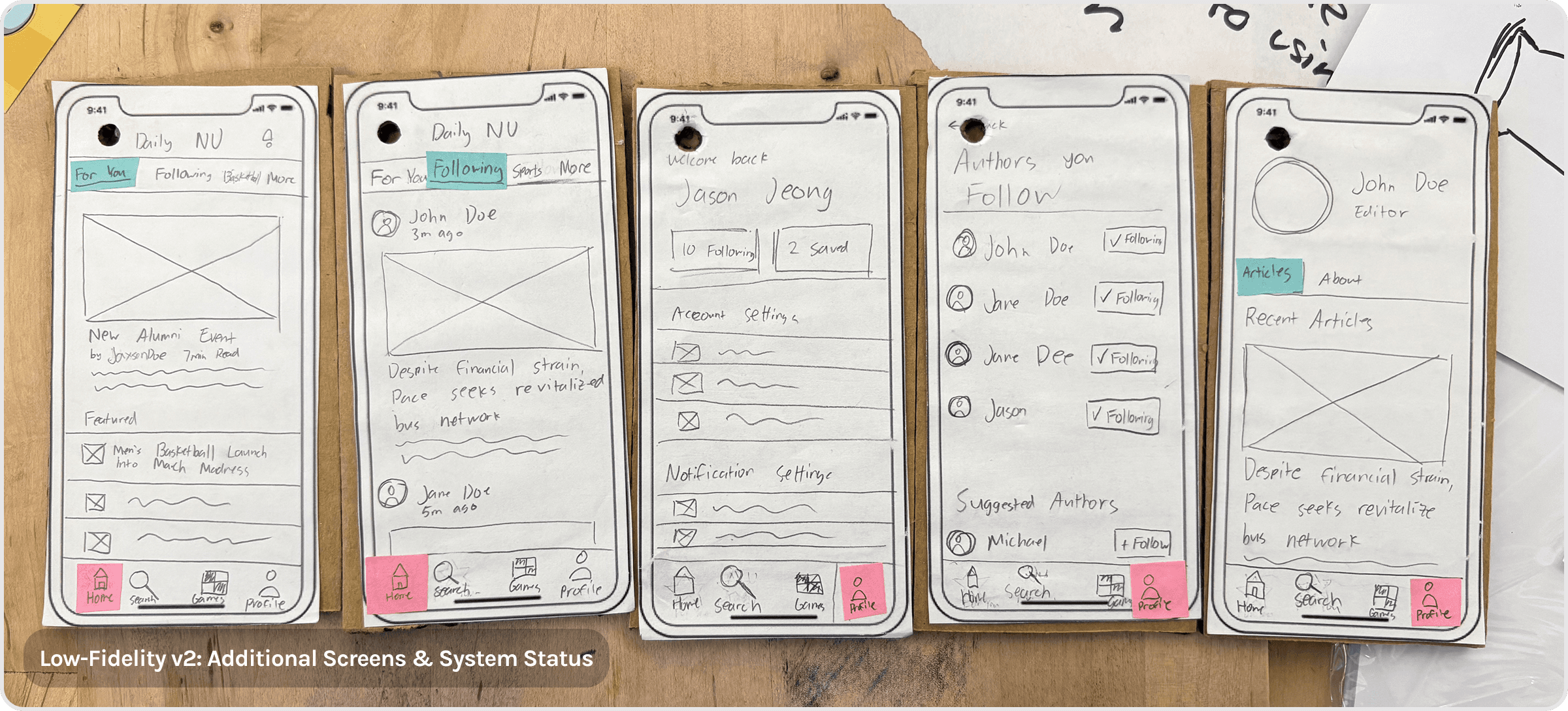


Realizing the importance of familiarity and mental models with applications
Realizing the importance of familiarity and mental models with applications
Realizing the importance of familiarity and mental models with applications
After this test with the second iteration of the design, I came to understand how important familiarity is important when it comes to designing any digital application. Without a proper mental model on how something works based on an individual's familiarty with existing apps, it is difficult to design and create something that people will understand.
After this test with the second iteration of the design, I came to understand how important familiarity is important when it comes to designing any digital application. Without a proper mental model on how something works based on an individual's familiarty with existing apps, it is difficult to design and create something that people will understand.



Low-fidelity v3: Creating multiple flows to a single destination
Low-fidelity v3: Creating multiple flows to a single destination
Low-fidelity v3: Creating multiple flows to a single destination
Understanding that users need freedom when using mobile applications, more screens and user flows were designed in order to allow users to achieve that freedom in navigating the mobile application.
Understanding that users need freedom when using mobile applications, more screens and user flows were designed in order to allow users to achieve that freedom in navigating the mobile application.
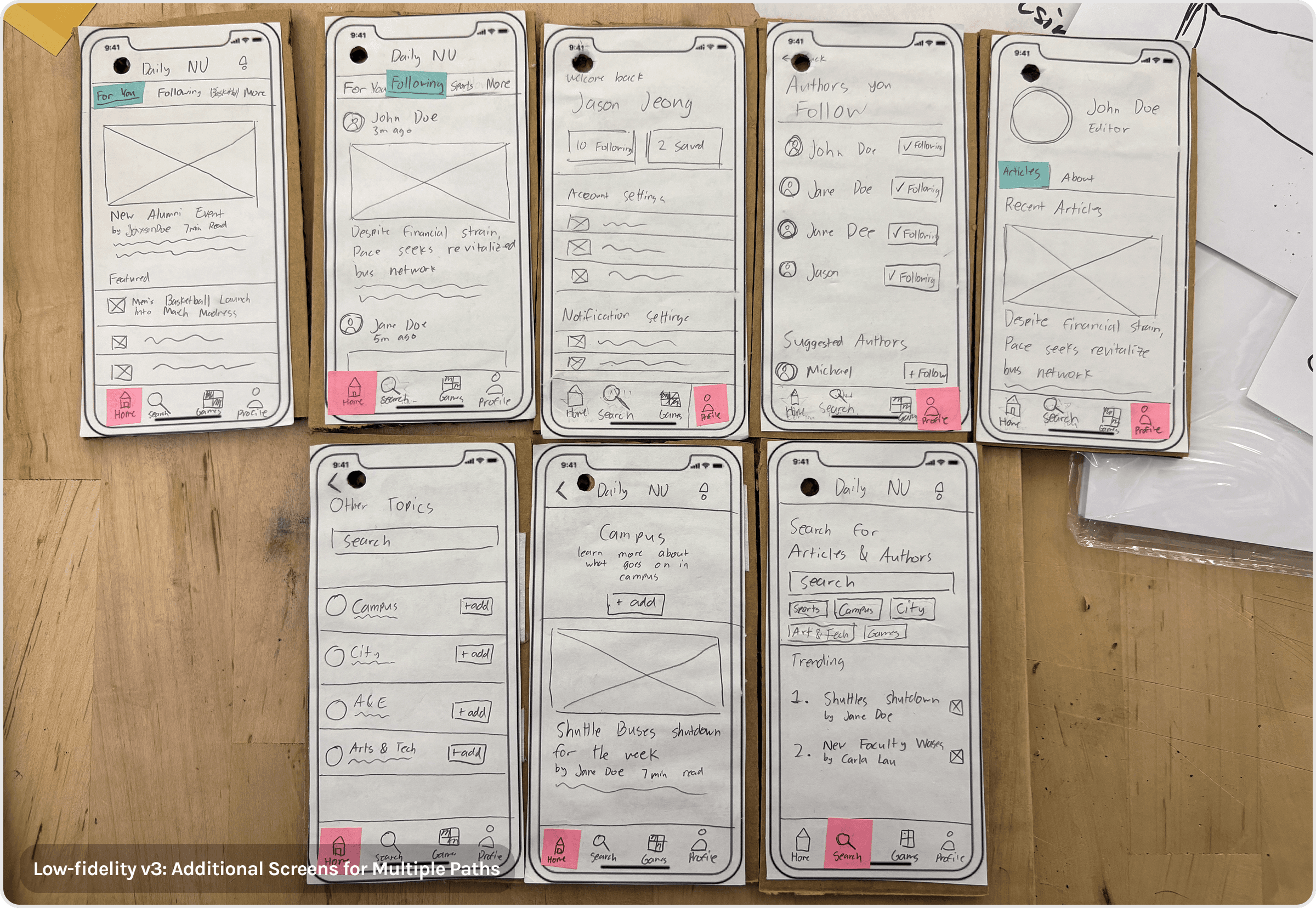


Validating the designs and features of the application.
Validating the designs and features of the application.
Validating the designs and features of the application.
After gaining feedback on user flows and being able to fully flesh out those, users were then finally able to focus a lot more on the actual core features of the application allowing me to truly validate specific features that would be implemented into the mobile application.
After gaining feedback on user flows and being able to fully flesh out those, users were then finally able to focus a lot more on the actual core features of the application allowing me to truly validate specific features that would be implemented into the mobile application.
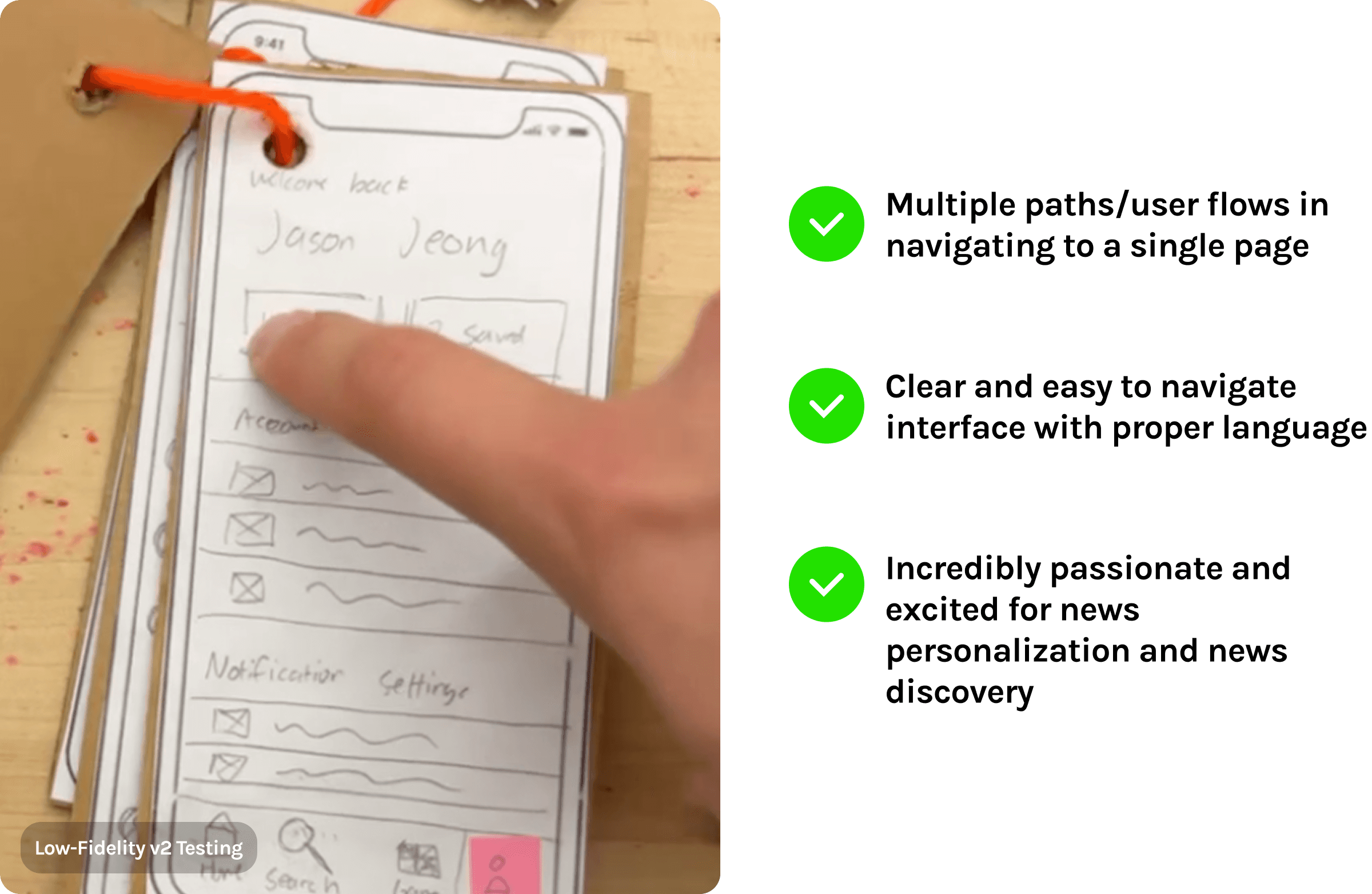


FINAL SOLUTION
The Personalized News Application
The Personalized News Application
A place for students and writers to come together and learn more about what peers are writing and understand whats going on throughout campus
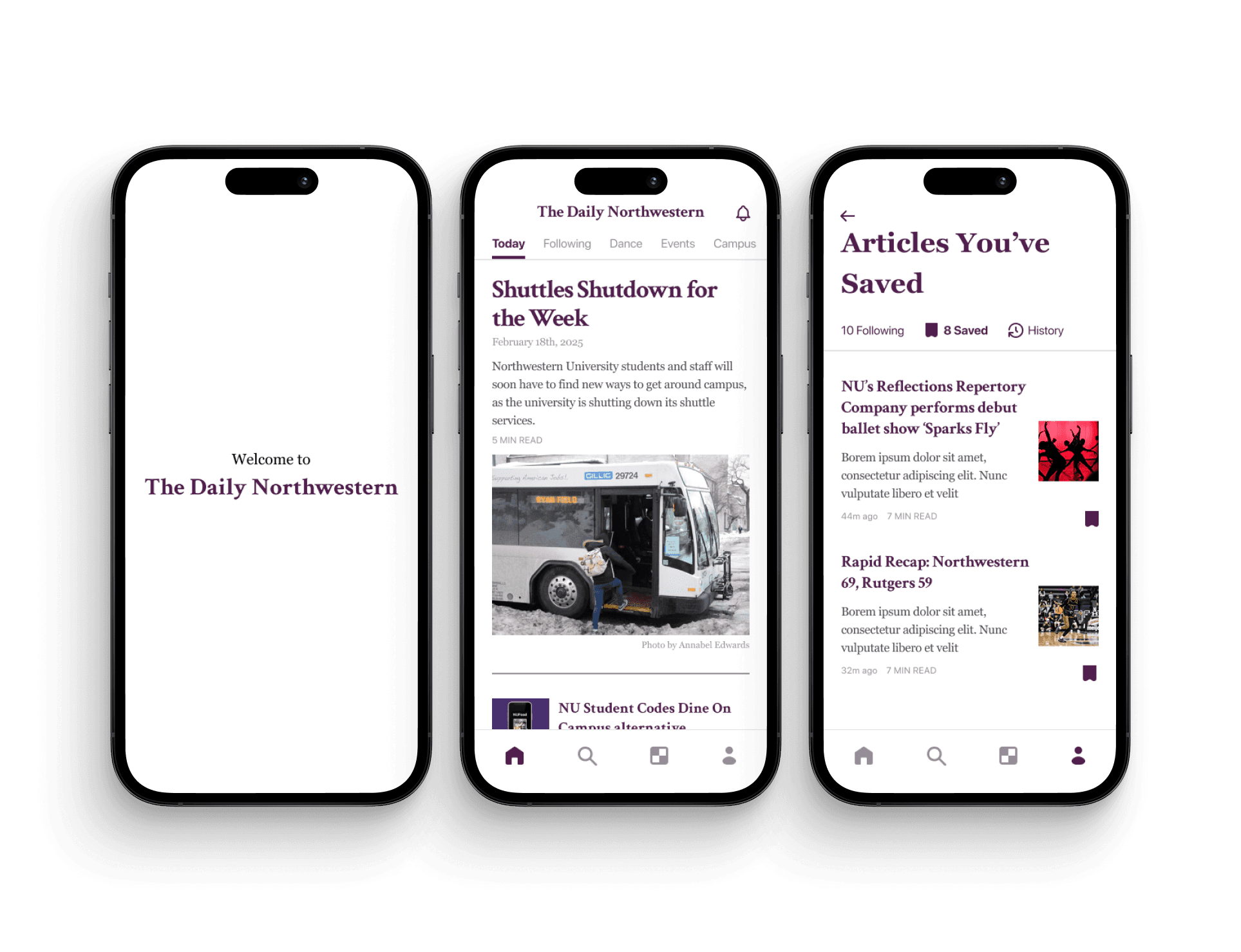


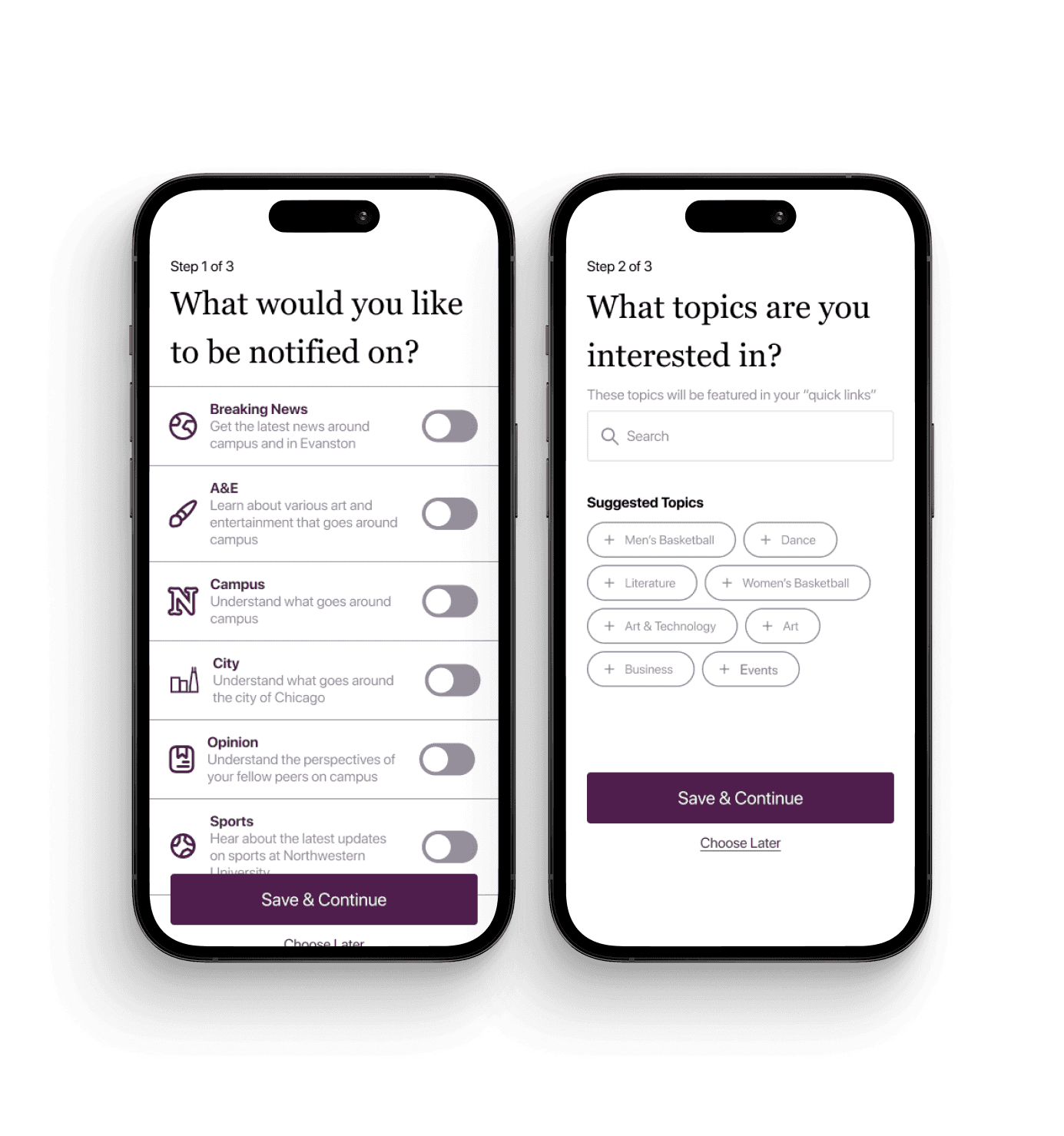


A Personalized Experience
A Personalized Experience
A Personalized Experience
Providing students with the freedom to pick and choose various topics that they are interested within campus news.
Providing students with the freedom to pick and choose various topics that they are interested within campus news.
Peer to Peer Connection
Peer to Peer Connection
Peer to Peer Connection
Allows readers to follow writers, motivating writers to produce more content while helping readers stay updated on their peers’ articles.
Allows readers to follow writers, motivating writers to produce more content while helping readers stay updated on their peers’ articles.
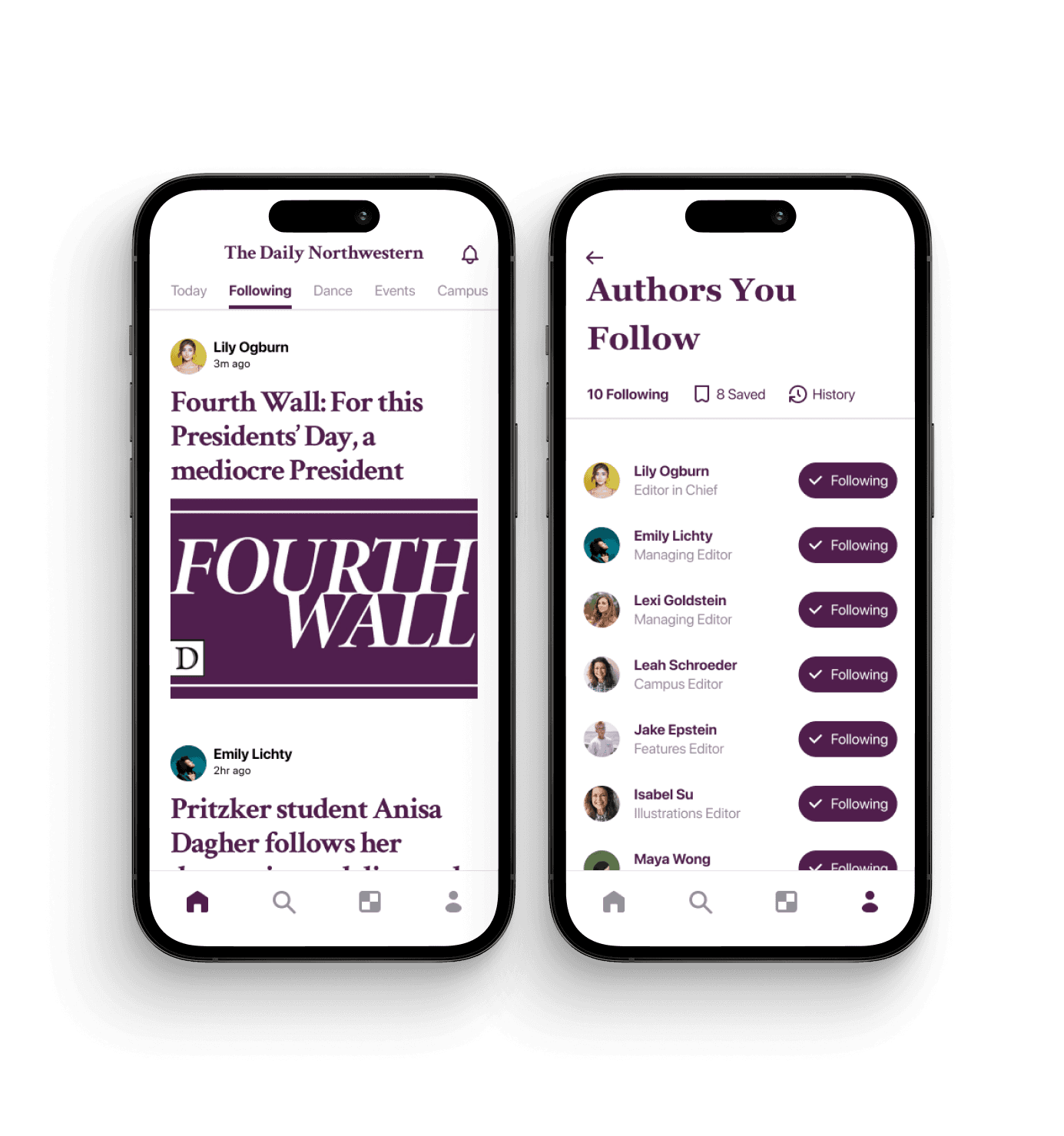


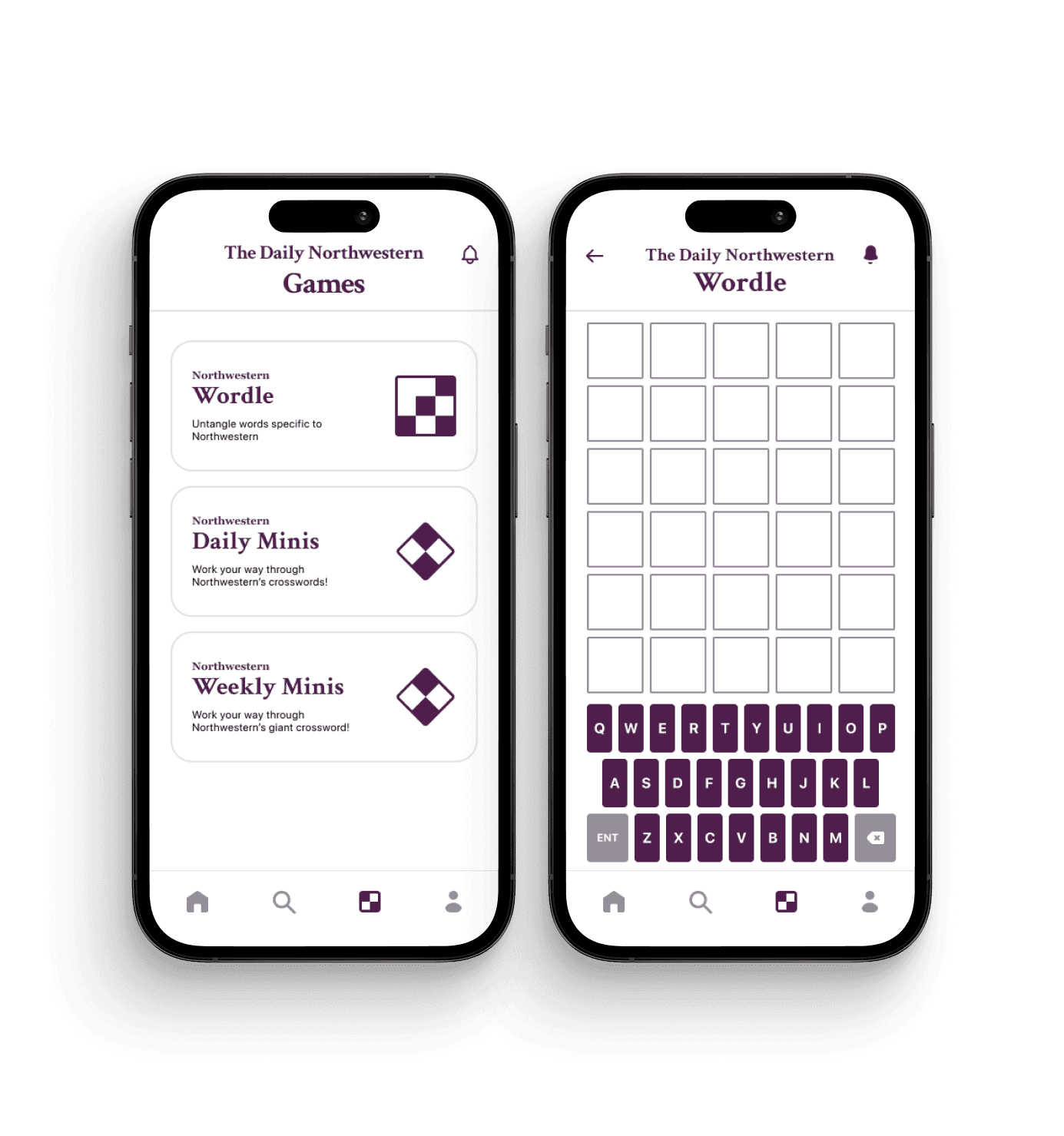


More Than Just News
More Than Just News
More Than Just News
To help build community and spark conversation, the app includes a dedicated Northwestern games panel, giving students a reason to return for more than just news.
To help build community and spark conversation, the app includes a dedicated Northwestern games panel, giving students a reason to return for more than just news.
Easier Discovery
Easier Discovery
Easier Discovery
Students can now easily discover authors and articles beyond newsletters, giving them more freedom to explore content on their own terms.
Students can now easily discover authors and articles beyond newsletters, giving them more freedom to explore content on their own terms.
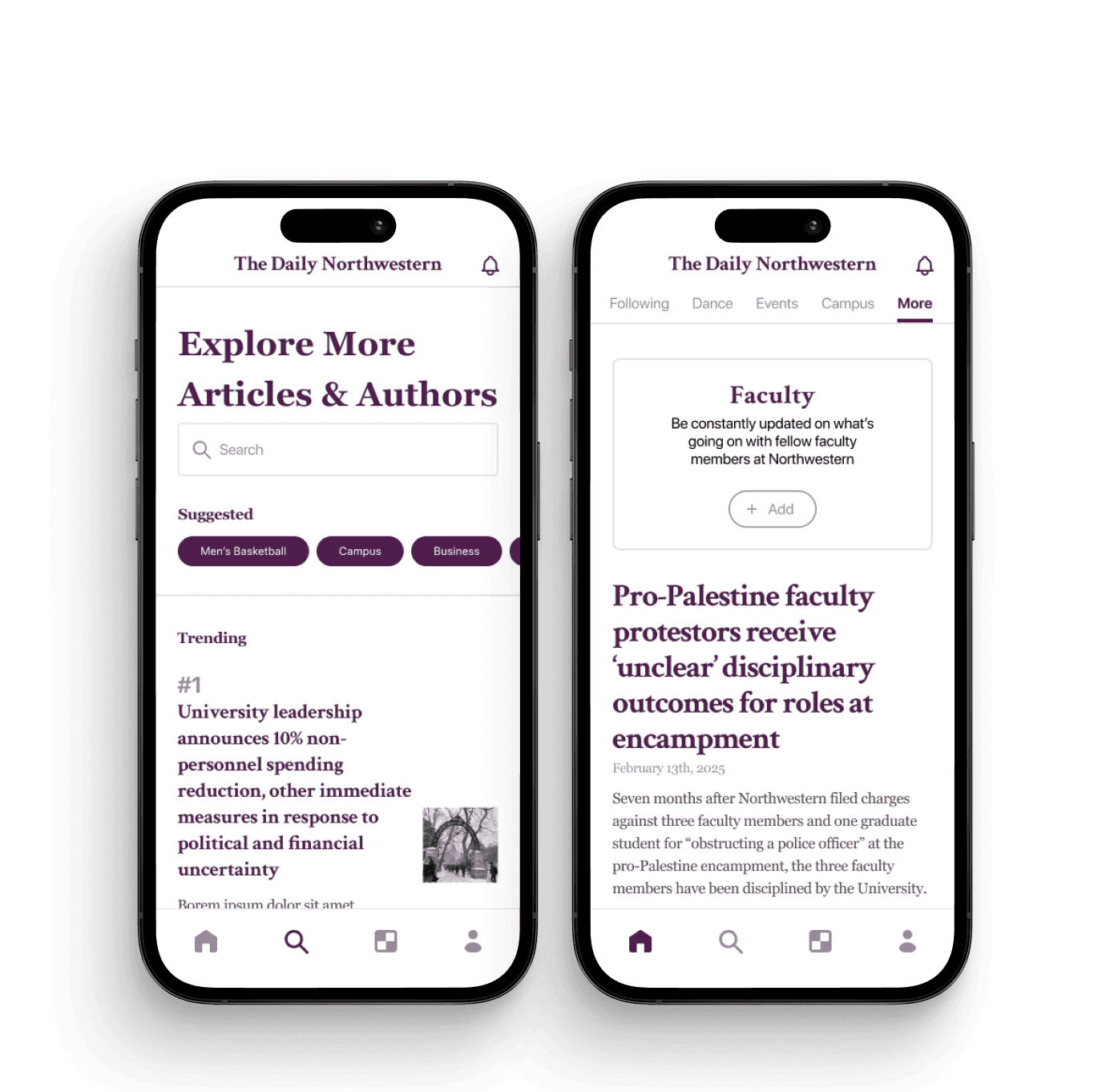


MAJOR TAKEAWAYS & LEARNINGS
MAJOR TAKEAWAYS & LEARNINGS
A project filled with failures leads to great growth!
A project filled with failures leads to great growth!
A project filled with failures leads to great growth!
Creating Value for Both Users and Stakeholders
Creating Value for Both Users and Stakeholders
While designing, I balanced user interactions with the project’s core business goals. This ensured the solution met both user needs and stakeholder objectives, creating a more holistic experience.
While designing, I balanced user interactions with the project’s core business goals. This ensured the solution met both user needs and stakeholder objectives, creating a more holistic experience.
Planning Prototypes for Effective Testing
Planning Prototypes for Effective Testing
Initially, I focused only on major features in my prototype. Without full flows, users became confused and distracted by areas outside the test. By expanding the prototype to cover the complete experience, I was able to direct feedback toward my actual goals and gather more meaningful insights.
Initially, I focused only on major features in my prototype. Without full flows, users became confused and distracted by areas outside the test. By expanding the prototype to cover the complete experience, I was able to direct feedback toward my actual goals and gather more meaningful insights.
Moving from Physical to Digital Prototypes
Moving from Physical to Digital Prototypes
While cardboard mockups helped signal to users that the design was an early prototype and encouraged feedback on core flows, the process proved inefficient. Cutting and assembling pieces took significant time compared to creating digital wireframes, making it an unsustainable workflow.
While cardboard mockups helped signal to users that the design was an early prototype and encouraged feedback on core flows, the process proved inefficient. Cutting and assembling pieces took significant time compared to creating digital wireframes, making it an unsustainable workflow.